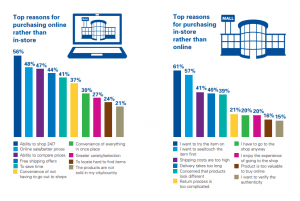Are you tired of hearing that physical retail is dying?
Us too.
Much like you, we believe in the importance of brick-and-mortar stores. Your brand is growing, your business is booming, and your customers are quickly becoming brand ambassadors. Your hard work is paying off, and that’s something to celebrate.
But some people would have you believe that it’s all for naught, that the end is nigh, that the writing is on the wall.
Of course, you shouldn’t believe everything that you hear. If you did, you’d be wire-transferring $100,000 to a Nigerian prince.
Spoiler alert: he’s not a Nigerian prince.
Have online sales overtaken sales in brick-and-mortar stores?
No.
The US Census Bureau recently released its retail and food services report for February 2019. Every category of online sales amounted to 11.813 percent of the month’s total sales, and one category of physical store sales amounted to 11.807 percent.
While all categories of online sales narrowly overtook a single category of physical sales, physical retail still reigns supreme when you take all of its categories into account (e.g. food and beverage stores).
In spite of this fact, multiple media outlets have published misleading articles: “Online Shopping Overtakes a Major Part of Retail for the First Time Ever,” “It’s Official: Clicks Have Topped Bricks,” and “Online Sales Surpass Brick and Mortar.”
Let’s be clear. Physical retail isn’t dying.
It’s evolving.
Different customers want different things.
E-commerce has its strengths and weaknesses, and the same is true for physical retail. Ultimately, the channel isn’t what’s most important, the customer is.
To best serve your customers, you have to make a concerted effort to understand and accommodate them. Instead of making them conform to a single channel, you must use multiple channels. Different customers have different priorities and preferences, and their purchasing habits can vary from category to category. Take me, for example. I prefer to purchase my groceries in the store and my electronics online.
Why do some customers prefer online?
According to a poll of 1,425 U.S. consumers by RetailDive, 62 percent prefer offline because they can see, touch, feel, and try out items, and 49 percent prefer offline, because they can take items home immediately.
Why do others prefer offline?
As stated in the 2017 Global Online Consumer Report, 56 percent prefer shopping offline because they have the ability to shop 24/7, and 47 percent prefer online because they have the ability to compare prices.
What about blending online and offline?
According to a study of 46,000 customers by the Harvard Business Review, 7 percent only shopped online, 20 percent only shopped in stores, and 73 percent shopped through multiple channels. These customers spent an average of 4 percent more in stores and 10 percent more online than customers who shopped through a single channel.
When customers research your products online and then complete their purchase in the store, they’re webrooming. When they research your products in the store and then complete their purchase online, they’re showrooming. According to a Harris poll, 69 percent of consumers webroom and 46 percent showroom.
When you blend your online and offline channels, you and your customers get the benefits of both. It’s a more profitable and personalized approach.
It’s win–win.
How is physical retail evolving?
While some people assert that e-commerce and physical retail can’t coexist, a number of companies are challenging that notion by blurring the lines between their online and offline sales efforts.
Click to brick
In the past few years, we’ve seen multiple online retailers open brick-and-mortar stores.
In an attempt to improve their customer service and position themselves as leaders in the physical retail space, Amazon unveiled a number of brick-and-mortar locations. The tech goliath launched Amazon Books in 2015, purchased Whole Foods in 2017, and debuted Amazon Go in 2018.
But it’s not just Amazon.
Online eyewear company, Warby Parker, and mattress startup, Casper, have also opened physical locations. Both companies have been able to innovate because of this shift.
At Warby Parker, customers are encouraged to showroom. If customers prefer to complete their purchase online, they can take a picture of their frames and add them to their cart. At Casper, customers are invited to try out the company’s beds at the Dreamery, a lounge where you can pay $25 for a 45-minute nap session. In this creative application of showrooming, customers are pampered with pj’s, beverages, and amenities.
Brick to click
On the flip side, physical retailers are also upping their online game.
Target incentivizes webrooming with Cartwheel, an app that the company released in 2013. With Cartwheel, customers can collect online coupons for in-store shopping. To offer their customers same-day delivery on groceries and more, Target also acquired the delivery startup Shipt in 2017.
Walmart is doing the same. The grocery giant has partnered with rideshare services to offer same-day delivery, and, in an effort to bring online shoppers into their stores, the company has started offering pickup discounts. Customers can purchase eligible products online and then pick them up in stores.
Conclusion
So . . . No, online sales haven’t overthrown physical retail sales. The future of retail isn’t online, and the future isn’t brick and mortar. It’s a combination of the two.
And that’s exciting!
Today’s retail space is ripe for disruption, innovation, and experimentation. By recognizing that different customers want different things, you’ll be able to better acquire, retain, and wow your customers.
Now, if you’ll excuse me, I have to email back a Nigerian prince.



